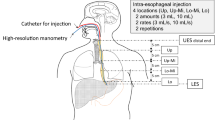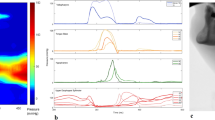Abstract
The aim of the study was to investigate whether a soft solid bolus can induce abnormal manometric patterns in patients with dysphagia and normal standard manometry. The study group comprised 12 normal volunteers and 22 patients with dysphagia. Manometry was performed using 10 wet swallows followed by 10 swallows of marshmallow. The results show: (1) in normal subjects the mean contraction amplitude is significantly greater (P<0.035) and the velocity of propagation significantly slower (P<0.003) for soft solid swallows compared with wet swallows; (2) in normal subjects there are fewer abnormal contractions after soft solid swallows than after wet swallows; (3) in 15 patients, soft solid swallows induced nonperistaltic contractions and/or contractions of extreme amplitude and/or duration that were not observed after wet swallows; 94) in patients, the probability of inducing abnormal contractions after soft solid swallows is significantly greater than after wet swallows (P<0.0001). We conclude that soft solid swallowing is useful in the study of patients with dysphagia.
Similar content being viewed by others
References
Benjamine SB, Richter JE, Cordova CM, Knuff TE, Castell DO: Prospective manometric evaluation with pharmacologic provocation of patients with suspected esophageal motility dysfunction. Gastroenterology 84:893–898, 1983
Mellow MH: Esophageal motility during food ingestion: A physiologic test of esophageal motor function. Gastroenterology 85:570–577, 1983
Allen ML, Orr WC, Mellow MH, Robinson MG: Water swallows versus food ingestion as manometric tests for esophageal dysfunction. Gastroenterology 95:831–833, 1988
Meyer GW, Gerhardt DC, Castell DO: Human esophageal response to rapid swallowing: Muscle refractory period or neural inhibition? Am J Physiol 241:G129-G136, 1981
Ask P, Tibbling L: Effect of time interval between swallows on esophageal peristalsis. Am J Physiol 238:G485-G490, 1980
Kramer P: Food ingestion as a provocative manometric test for esophageal dysfunction. Gastroenterology 9:959–960, 1989 (letter)
Dalton CB: Measurements and interpretations.In Esophageal Motility Testing. DO Castell, JE Richter, CB Dalton (eds). New York, Elsevier Science Publishing, 1987, pp 66–78
Clouse RE, Staiano A: Contraction Abnormalities of the esophageal body in patients referred for manometry. A new approach to manometric classification. Dig Dis Sci 28:784–791, 1983
Richter JE: Normal values for esophageal manometry.In Esophageal Motility Testing. DO Castell, JE Richter, CB Dalton (eds). New York, Elsevier Science Publishing, 1987, pp 79–90
Castell DO: The nutcracker esophagus and other primary esophageal motility disorders.In Esophageal Motility Testing. DO Castell, JE Richter, CB Dalton (eds), New York, Elsevier Science Publishing, 1987, pp 130–140
Freidin N, Mittal RK, Traube M, McCallum RW: Segmental high amplitude peristaltic contractions in the distal esophagus. Am J Gastrenterol 84:619–623, 1989
Benjamin SB, Gerhardt DC, Castell DO: High amplitude peristaltic esophageal contractions associated with chest pain and/or dysphagia. Gastroenterology 77:478–483, 1979
Mellow M: Symptomatic diffuse esophageal spasm. Manometric follow-up and response to cholinergic stimulation and cholinesterase inhibition. Gastroenterology 73:237–240, 1977
Katz PO, Castell DO: Review: Esophageal motility disorder. Am J Med Sci 290:61–69, 1985
Dooley CP, Schlossmacher B, Valenzuela JE: Effects of alterations in bolus viscosity on esophageal peristalsis in humans. Am J Physiol 254:G8-G11, 1988
Dooley CP, Di Lorenzo C, Valenzuela JE: Esophageal function in humans. Effects of bolus consistency and temperature. Dig Dis Sci 35:167–172, 1990
Sears VW Jr, Castell JA, Castell DO: Comparison of effects of upright versus supine body position and liquid versus solid bolus on esophageal pressures on normal humans. Dig Dis Sci 35:857–864, 1990
Applegate GR, Malmud LS, Rock E, Reilley JR, Fisher RS: “It's a hard pill to swallow” or “Don't take it lying down.” Gastroenterology 78:1132, 1980 (abstract)
Fisher RS, Malmud LS, Applegate G, Rock E, Lorber SH: Effect of bolus composition on esophageal transit: Concise communication. J Nucl Med 23:878–882, 1982
Castell DO: Esophageal motility disorders: The specter of the spectrum. Dig Dis Sci 30:188–189, 1985 (Letter)
Author information
Authors and Affiliations
Rights and permissions
About this article
Cite this article
Keren, S., Argaman, E. & Golan, M. Solid swallowing versus water swallowing: manometric study of dysphagia. Digest Dis Sci 37, 603–608 (1992). https://doi.org/10.1007/BF01307587
Received:
Revised:
Accepted:
Issue Date:
DOI: https://doi.org/10.1007/BF01307587




